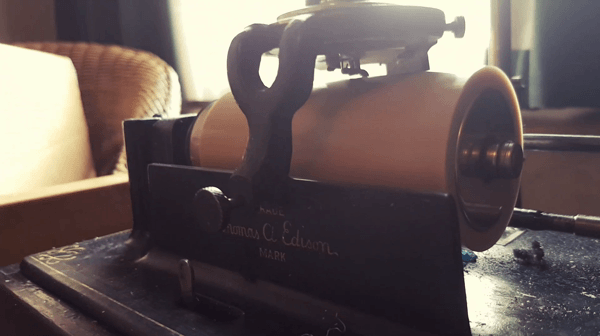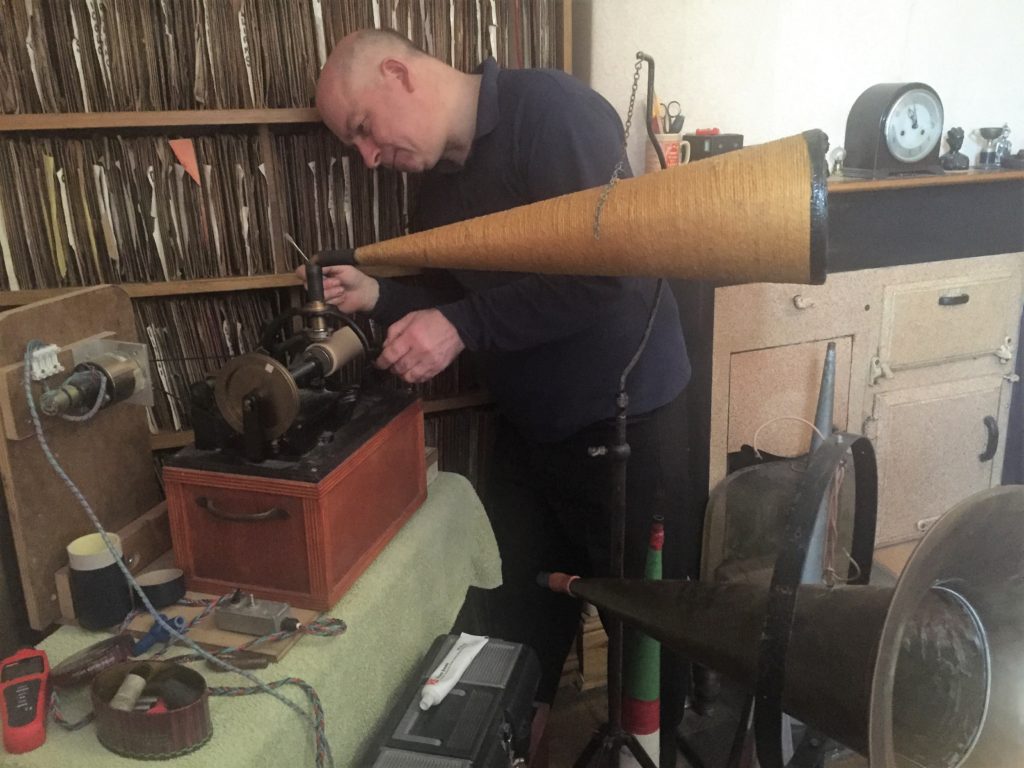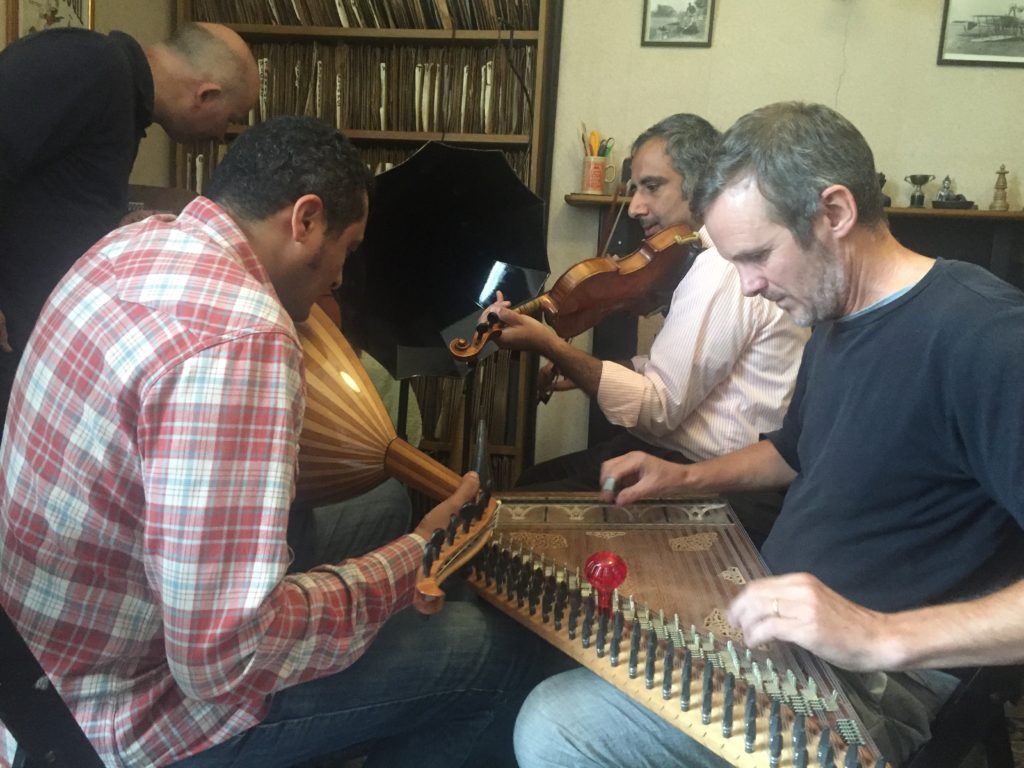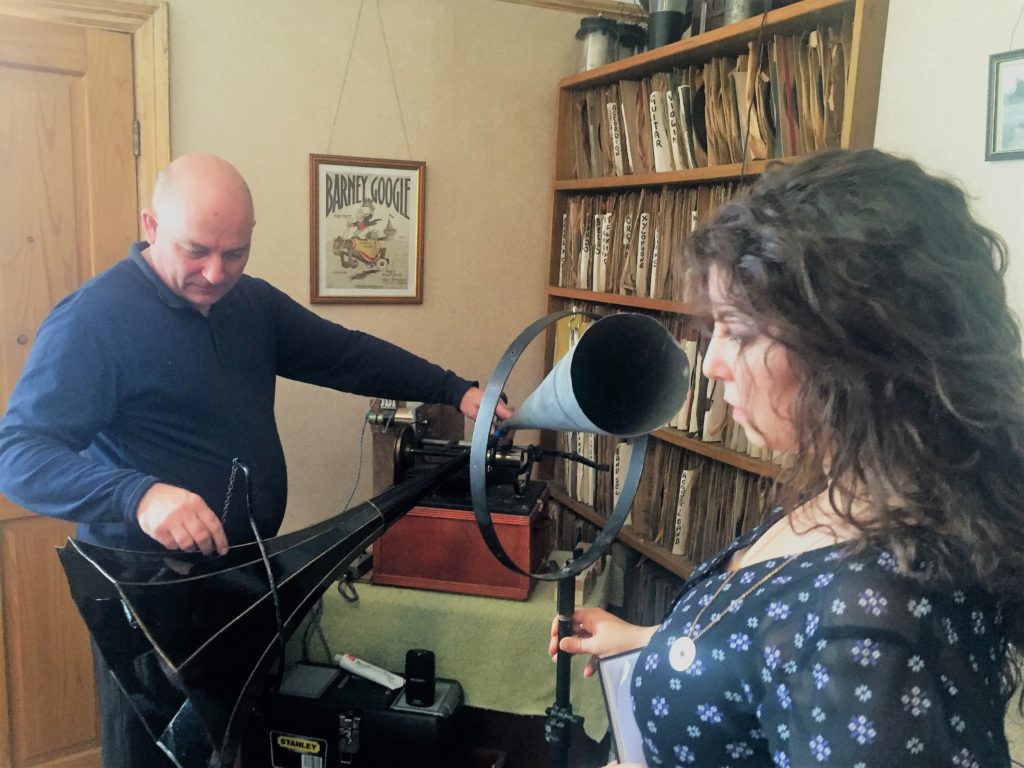By Yara Salahiddeen and Martin Stokes
All photo credit goes to Oxford Maqam

The sound recording industry blossomed in the Ottoman and Arab world at the turn of the twentieth century. Initially in the hands of entrepreneurs like the Blumenthal Brothers in Istanbul, British, French and German companies (like Gramophone, Pathé and Odeon) were soon to take over. Competition to sign the big stars – like Egyptian vocalist Yusuf al-Manyalawi (1847-1911) – heated up. Technology changed quickly, too. The earliest entrepreneurs had started with the wax cylinder phonograph, patented by Edison in 1887. Phonographs were a remarkable invention – portable, robust and, eventually, affordable. But the cylinders on which they recorded and played back sound were none of these things. They were hard to duplicate, fragile, and wore out quickly on repeated playing. By 1903, shellac disc recording began to take over.
Wax had a short life in the Arab world, then, and few commercial phonograph recordings survive. Those that do are notable, for instance Abduh al-Hamuli’s ‘Inta Farid fil Ḥusn’, probably recorded in 1900. Ethnographic wax-cylinder recordings from the region may have fared rather better, because they ended up sitting quietly on shelves in museums, like Benjamin Gilman’s 1893 recordings of the Abu Khalil al-Qabbani troupe at the Chicago Columbian Exhibition in 1893, or Snouk Hurgronje’s recording of the call to prayer and various items of song repertoire in Arabia, made in 1906, or Robert Lachmann’s of Tunisian musicians in German POW camps recorded during the First World War, currently in the Berlin Phonogramme Archiv.
Most of this archive, whether in wax or shellac, has been in private hands until relatively recently. Arab world states have certainly not made archiving them any kind of priority. One assumes they are an irrelevance, at best. For a while, young Arab musicians have had almost no opportunity to learn about the music of the generations that preceded Umm Kulthum and Mohammed Abd al-Wahhab. With advances in sound digitization, internet archiving and social media, the old recordings have started to circulate again, however. Through the curatorial efforts of the Arab Music Archiving and Research Foundation (AMAR) in Beirut, and online communities such as Zaman Al-Wasl and Sama3y, they have become a vivid musical reality over the last decade. Archives have, in short, proliferated and their sounds liberated.
The current situation – an embarrassment of riches – prompts questions, though. Recording, we know, shaped aesthetic norms and standards in the Arab world – how men and women sang, how instruments were made and played, how songs were written, and, of course, how people listened. It marginalized lengthy Ottoman instrumental forms (for instance, the bashraf), Ottoman improvisatory practices (taqsīm), and bookish forms of maqam (modal) theory associated with it. It affected the wasla suite form, curtailing, for example, the hank wa rank (call-and-response) vocal improvisations of the dawr. It made stars of (male) vocalists, like Yusuf al-Manyalawi and Abd al-Hayy Hilmi. Its effects on professional female vocalists (‘alma) were more complex. It saved for posterity those of them who sang adwar; it gave a platform for those who sang other repertories (e.g. taqtuqa); it opened these repertories to exploitation by male performers. It marginalized knowledgeable listeners (sammī’a), too, who musicians considered indispensable to a successful performance. Early recordings would include calls of encouragement from listeners in the studio, as though acknowledging this lack. In all of these discussions, shellac disc recording is assumed as the norm. But wax cylinder recording preceded shellac, for a brief, but important, period of time. If we are to understand the changes more deeply, what do we need to know about wax? What do we need to know about the nature of the sounds that are inscribed in it, and the technologies and labour required to get them there?
Oxford Maqam, an ensemble of Arab and British musicians and scholars devoted to the musical art of the Arab world of the late 19th and early 20th centuries, found themselves pondering these questions in 2016. Four of the ensemble, Ahmed al-Salhi (voice and violin), Tarik Beshir (voice and ‘ūd), and the two authors of this essay, Yara Salahiddeen (voice) and Martin Stokes (qanūn), set off one morning from Oxford to spend the day with Duncan Miller, owner and operator of Vulcan Records in Sheffield. Miller is a sought after consultant at various institutions including the National Library of Norway and the Royal College of Music. Vulcan Records specializes in wax cylinder production for a burgeoning retro recording market. Its activities rest on Miller’s extensive knowledge, and collection of early industrial sound recording technologies. Sheffield, once full of noisy textile and steel factories, and needing such devices for workplace messaging, turns out to be full of them. We had no idea what to expect. We were simply curious to see what would happen if we returned this wax repertoire to its original medium.

The plan was to record a representative handful of items from this period: an old instrumental bashraf (‘Murabba’ al-Bayyati’), one of the shortened, Arab kind; and a taḥmīla (‘Taḥmīla Ṣaba’), one of the instrumental genres that seemed, by contrast, to have thrived on wax; a forgotten vocal dawr from the late nineteenth century of which there are just two known recordings, one by ‘alma Asma al-Kumsariyya, known to us only through much later recordings, ‘Min Yawm ‘Irift al-ḥubb’; another, ‘Gaddidi Ya Nafs Ḥazzik’, that would allow us to see what happened to it, shorn of its vocal improvisations and compressed back into a strophic song form; two muwashshah, ‘Ya Hilālan’ and ‘Hagarni Ḥabībi’, for the same reason; a mawwāl, ‘Ya Badr Timm il-Gimīl’, to explore vocal improvisation under such tight constraints. We moved more quickly than we expected and found time at the end of the afternoon to include two Arabian ṣawt-s, to take advantage of Ahmad al-Salhi’s presence. This was an afterthought, but it gave us an opportunity to consider the early Egyptian material alongside something else from the period. We had not counted on how quickly, in Duncan’s expert hands, we would move. Otherwise, it was not a bad plan. Readers can, by the way, find all these recordings on YouTube, and translations of the lyrics and other commentary on our website.
But we were not at all prepared for the experience – which was both uncanny, and strangely moving. One aspect of this was the sense of immediacy and intimacy engendered by the device itself. You could see how it worked as you played. Pressure waves from our voices and instruments entered the horn, which vibrated the diaphragm, which wiggled the needle, which inscribed an indented line on the revolving wax, inches away from our faces. Playback simply reversed the process. The simplicity of the device seemed – to those of us who had grown up with studio recording – little short of miraculous. And how utterly strange to hear our voices travel back in time. Were we ‘there’, transported, with crackle and hiss, a century back? Or had we been possessed? Footage captures our faces at this moment. It looks as though we had seen a ghost.

We learned as we went along, presumably as our predecessors once did. Instruments needed to be arranged at variable distances from the hearing ‘horn’ to balance their sound. Loud instruments needed to be further away, quiet instruments needed to be closer. The ‘ūd, surprisingly – because human ears pick it up easily – needed to be very close. Equally surprisingly, the qanūn, typically thought of these days as a quiet instrument, needed to be placed at a distance. Even then, it could easily overwhelm things. The wax picked up its percussive qualities, particularly in middle register – dispensing entirely with any need for a percussion instrument. It was easy to see how the qanūn, and key performers on it like Abd al-Hamid al-Quddabi and Mohammad al-Aqqad, were to dominate these early ensembles. It was also easy to see why it would be so regularly paired with the violin – the one plucked and percussive, the other bowed and sustained. The two players could arrange themselves in front of the recording horn, dividing up the accompaniment and targama (translating) tasks between them on the hoof. The relative unimportance in this period of ‘ūd and nay – neither of which, by contrast, wax hears ‘easily’ – also becomes comprehensible.
Singers sang into a horn, aware of the rolling cylinder but unable to make easy eye contact with other instrumentalists. As the cylinder wound to an end, eyes needed to be focused, we found, on Duncan and his gesticulations. This made listening for that cohesive takht sound all-the-more deliberate, whilst simultaneously making the singing act more solitary. It is said that suspicious singers had to be coaxed into performing on the ‘talking machine’; some of the most renowned artists initially felt it to be an inferior, perhaps even harmful phenomenon. It clearly changed the voice. We were surprised to hear Yara’s voice –compressed as it had been into a small bandwidth by the wax– emanating as the higher-pitched, almost tinny, sound of the ‘awālim we were so familiar with. The male voices were more diverse, more characterful on wax, as they unfolded on a broader spectral palette. Ahmad’s bass tones were the most recognisable as himself, bringing the past and present crashing together in a most disconcertingly happy way. Somewhere in the middle of this distortion was Tarik, whose tones seemed translated by the machine into those of renowned singer Sheikh Sayyid al-Safti (1875-1939).

In all voices, we noticed how the effect of certain ornamentations was exaggerated whilst some faults seemed masked, which made us question our understanding of the delivery of the original artists we study. Did singers adjust their ornaments or timbre to compensate for changes they heard caused by the phonograph? We found ourselves wondering whether we work our way back digitally and ‘hear’ their original voices, much like the colourisation of black and white photography.
Our efforts to adjust to the device were for the most part intuitive. But in one area it made extremely exacting demands: speed. One needed, we discovered, to be able to judge tempi to the millisecond. Too slow, and the disc has come to an end before the song. Too fast, and there was dead air at the end – undesirable on such expensive objects. Improvisation and inventive interpretations in muwashshahat and adwar were highly valued on the part of singers, to add to the complexity of the calculations involved. Accompanying musicians needed to make intricate, in-the-moment decisions, not just about speeds and durations, but about the maintenance of coherence within the tightest imaginable margins. Cylinders did not last long, as mentioned, because the phonograph needles quickly wore down the wax grooves. So, demand was high, schedules were tight, and efficiency was all. It became easy to see how small numbers of vocalists and instrumentalists – those few with the requisite work ethic and instinctive feel for the medium – might have so comprehensively dominated this early recording market.
There is already something familiar about the idea of playing with ‘obsolete’ sound recording technologies – a hipster cliché, perhaps, a rejection of life in the desert of the digital. But musicologists, sound historians and critics have been taking the idea increasingly seriously. We clearly have important things to learn about past sound worlds from old recording technologies, just as we do from historic instruments, historic acoustic environments, and documents revealing how people once listened. Such insights may have special meanings in the Arab world. The Egyptian state’s neglect of this archive – which has hidden the pre-Umm Kulthum repertoire from several generations of musicians in the Arab world – is no longer an obstacle. Sounds from this period are now in circulation. What might this change? It is hard to say. The interests of many are at stake, not just those of the state. We live at a point in time, though, when ‘obsolete’ and new media overlap, and the opportunity to play with them is one we would do well to seize and enjoy.
Yara Salahiddeen is an Ertegün scholar and doctoral candidate at the Oriental Institute, Oxford University. She is interested in Egyptian musical cultures of the 19th and 20th centuries which she explores in her research and as a vocalist in the Oxford Maqam ensemble.
Martin Stokes is King Edward Professor of Music at King’s College London – and currently a Fellow at the Leverhulme Foundation (2019-2022)– and plays qanūn with the Oxford Maqam ensemble.
